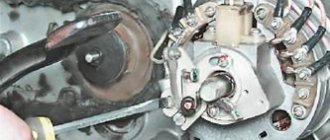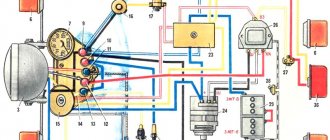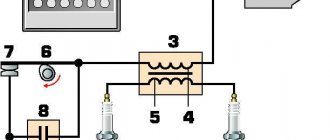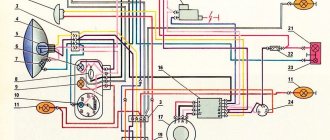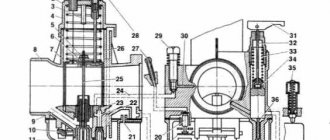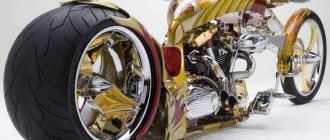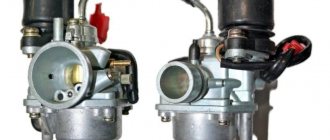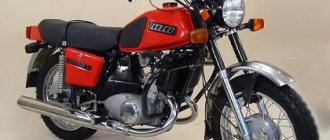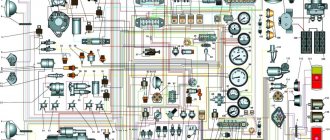For various reasons, you may be the owner of a legendary Java - it’s your father’s, older brother’s motorcycle, or you just bought a legendary vehicle for the occasion. But here’s the problem - the motorcycle is often far from ideal condition, for example, you may be upset by such a nuisance as the wiring of the Java, which has delaminated from old age, was probably stored in an unheated barn or garage, and a new set cannot be found in your city.
There are few well-groomed specimens of Java left
What’s most annoying is that the work of replacing most parts and assemblies is quite simple , but the lack of spare parts immobilizes your vehicle indefinitely. Moreover, the price of parts tends to rise every year, which forces us to show skillful hands and ingenuity. But the result lives up to all expectations.
IL as a donor of spare parts
Let's consider, for example, the transition from 6 volts to 12 volts electrical equipment, and we will borrow the parts for such a conversion from the IZh motorcycle - fortunately, there are quite a lot of them sold in the post-Soviet space.
Note! Motorcycle manufacturer JAWA itself changed the voltage on its next models. And it would be more logical to use original parts, but, as mentioned above, the lack of spare parts and their exorbitant price do not provide such an opportunity.
The wiring to Java will remain the same - if its condition is satisfactory, but the lamps and coil will have to be replaced. But you will get a more powerful system, which will affect all the characteristics of the motorcycle.
Scheme with decoding
Advice! If you decide to make such a modification, you will also need a Java 12 V wiring diagram, presented above in high resolution (1000x700)
Reasons for alteration:
- Elimination of weak headlight light is a phenomenon common to all Javas with 6V equipment;
- Elimination of undercharging of the battery during prolonged driving at low speeds;
- Breakdowns and failures due to wear of original 6V parts;
- Inability to purchase original components and consumables;
What do we take from the domestic motorcycle industry?
Note! The 12-volt IZh components are quite easy to adapt to the 634 motor with your own hands. That is why this modification should be considered as a working option.
You have to “implant” domestic details into the Java scheme
Advice: There are modifications using parts from Chinese Delta scooters and mopeds. But we do not recommend them, since the quality of the parts is not up to par.
In fact, we will need a minimum set of parts from IZH:
- relay-regulator, indicated in the photo below under No. 1;
- generator rotor (under No. 2);
- stator windings (under No. 3);
- supply wire to the ignition switch at terminal 54 (under No. 4).
For reference: also on the installation diagram of “Izhevsk” parts in the Java electrical circuit, the terminal markings of the relay-regulator block are indicated (from X1 to X8).
Custom parts
Faceplate for the generator - you can order it from a familiar turner
You can't do it without the help of a turner. If so, then start by searching for him through friends or newspaper advertisements.
You will order him:
- Adapter washer (faceplate) for installing the generator;
- Modification of the stator - the side facing the crankshaft will have to be shortened;
- Groove of the seat.
Note! The stator should not be modified in a garage, because It will be difficult to maintain the bore diameter accurately. And in the future, after assembly, the rotor will probably touch the stator coils, which will lead to their increased wear.
The video below demonstrates the operation of a Java motorcycle with a 12-volt generator from IZH.
This is exactly the result that you will get if you follow the proposed procedure for modernizing your Java.
Operational Features
It was the motorcycle in our country that became a clear confirmation that a two-wheeled vehicle is truly a means of transportation.
The owners and their “iron horses” could be found everywhere:
- In the forest thicket;
- In the mountains;
- On city highways;
- In the rural outback;
- At sports competitions, etc.
On a JAWA motorcycle you could easily travel 1000 km from home.
Its endurance and reliability on the longest routes contributed to such a high popularity of the brand as a whole. Even the resale of a 5-year-old copy brought the former owner at least 500 rubles.
For reference: Purchasing new domestic two-wheeled motorcycles cost more modest sums for the family budget. The shortage of spare parts, missing instructions and minor breakdowns did not stop me from buying my dream motorcycle.
However, difficulties with parts and a simple design contributed to the fact that owners serviced the motorcycles with their own hands in a variety of places:
- In private garages;
- In the back rooms;
- On the balconies;
- In apartments, etc.
The lack of a garage has never been a hindrance to a true motorcycle enthusiast
Alteration work
Let's start working directly in Java.
The modification instructions will be as follows:
- We fasten the faceplate with M6 bolts. We use only with flush-mounted heads, since regular bolts will interfere with the operation of the rotor.
Installing the faceplate
- We install the rotor and check its rotation. It should rotate freely and without play on the axis.
If the faceplate is installed correctly, the rotor will rotate freely
- We clamp it together with the flange under the modulator using a bolt.
- We mount the stator. First, we remove the terminal of the center of the stator windings - it will be needed for the relay for the generator operation indicator lamp.
We bring out the terminals for connecting a car relay from a VAZ 2101 to a control lamp
Note! The use of parts from VAZ is also practiced in modifications to cars of other domestic brands. In particular, the wiring diagram of the UAZ 31514 was built using a switch from a VAZ 2108.
- We connect the wires.
- Install the breaker plate.
Installation of the plate. This option is made with a Hall sensor
Tip: installing an ignition using a Hall sensor makes the moment of sparking more predictable, which improves ignition of the mixture. Since we are modernizing electrical equipment, it makes sense to improve the ignition system at the same time.
That's all. All that remains is to check the functionality of our modernization, for which we start the engine with the cover removed. If necessary, set and adjust the ignition angle.
Electrical equipment Jawa 634
(Click on the picture to enlarge)
1— main headlight lamp (6 V, 35+35 W); 2— parking light lamp (6 V, 4 W); 3— direction indicator lamp (6 V, 15 W); 4— lamp for monitoring generator operation (6 V, 2 W); 5 — high beam warning lamp (6 V, 2 W); b — speedometer lighting lamp (6 V, 2 W); 7 - central switch; 8 — turn signal interrupter relay; 9 — sound signal; 10 — switch for low-high beam with a button for turning on the sound signal; 11 — turn signal switch; 12 — capacitors; 13 and 14 — contacts of the ignition interrupter of the left and right cylinders; 15 and 16 — spark plugs; 17 — ignition coils; 18 — brake light switch; 19 — relay-voltage regulator; 20 - battery (6 V, 14 Ah); 21 - generator (6 V, 75 W); 22 - fuse (15 A); 23 — brake light lamp (6 V, 15 W); 24 - parking light lamp in the rear light (6 V, 5 W).
1979N07P20
Motorcycle chassis
The frame of this model is universal and made of durable components and materials. This was necessary in order for the motorcycle to work well with maximum load capacity and the installed sidecar. The telescopic fork Java 350 634 is made in such a way as to ensure confident movement not only around the city, but also in difficult terrain. Therefore, hydraulic front shock absorbers and a wheel with steel coil springs were installed.
To ensure good stability of the motorcycle on slippery roads, it was decided to install a wide rear fork support. By the way, the pendulum-type fork holds the rear wheel perfectly, which ensures traction.
Electrical diagram
The electrical circuit of the YAVA 638 has been modernized based on the wiring of the previous model. The experimental 12-volt equipment was completely replaced and required the installation of a larger battery. Features of this innovation:
- the appearance of a 210-watt generator;
- possibility of installing an additional fog lamp;
- The stroller consumers were provided with current from a standard generator.
Thanks to the new system, the level of luminous flux was increased, which ensured driving safety at night. Spark formation has also improved, which contributes to more uniform and dynamic engine operation.
The new generator contains such basic elements as a rotor, stator and a metal casing. Its efficiency significantly exceeds the previously used 6-volt generator. This system allows charging even when the engine is running at low speeds.
However, the created system generated direct current, which needed to be converted into alternating current. For this purpose, a rectifier was built into the system. Its convenient location under the saddle makes it easy to carry out maintenance yourself.
However, when installing such equipment, the problem of overheating of the generator walls arose. It became impossible to use the rectifier inside a metal casing, so it was located under the driver's seat, providing air flow to cool the system.
The permissible power to a temperature of 150 degrees Celsius was 15 amperes. With the stroller and the use of all devices, it became possible to connect one additional consumer that does not require more than 40 watts of power.
Five random articles about motorcycles:
Java is 60 years old!
Java is sixty!
Is this a lot or a little for a motorcycle brand? If compared with the first Czech motorcycle “Laurin and Klement”, which appeared thirty years earlier, JAVA is not so old. But in this case, it is not the date of birth that should be taken into account. Of the more than 2,500 different brands of motorcycles that have ever been produced in the world and included in the “Illustrated Encyclopedia of Motorcycles” (there is one in the West), there are barely a dozen like YAVA, with such a rich history. It began in 1929, when the owner of the arms factory, Frantisek Janeček, presented at the Prague Motor Show his first motorcycle, built under a German license (from the initial syllables of these surnames, as is known, the name JAVA was born). It was a rather expensive and heavy machine weighing 175 kg, equipped with a single-cylinder four-stroke engine with a displacement of 498.7 cm3 and a power of 18 hp. s./13 kW, which did not have commercial success. Eh... Read more >>
How to remove cylinders easier in Java. Protective pads for studs
Protective gaskets for studs After long-term use of a YAVA motorcycle, especially in rural areas, it can be difficult to remove the cylinders: dust and sand, mixing with oil, tightly clog the holes for the studs.
In addition, during disassembly, some of this dirt gets into the crankcase, no matter how hard you try to close it. Head gasket I got rid of this trouble in the following way. I cut out six gaskets from raw rubber about 2 mm thick (according to the picture) and put them on the studs before installing the head. When the engine heats up, they vulcanize and reliably close the holes from dust. I have been successfully using this method for several years now. V. KOROTCHIKOV Gomel region, Ozerany 1989N07P33 Read more >>
Motorcycle IZH Jupiter 4 with sidecar
The first material about editorial tests of the IZH-Jupiter-4 motorcycle with a sidecar (“Behind the Wheel,” 1981, No. 11) talked about what distinguishes this model from the previous ones, and about the beginning of the run-in.
Now the motorcycle has covered about 7,000 kilometers, and there is an opportunity to evaluate its driving performance and the design of some components. When the speedometer showed just over 6,000 kilometers and the engine was running perfectly, we began to be bothered by a noise, the source of which was somewhere under the left crankcase cover. The noise is not loud, but quite unpleasant (note that, unfortunately, this sound is well known to many Jupiter fans). The assumption arose that the fault should be looked for in the motor chain drive. When the crankcase cover was removed at a service station in Zagorsk, the diagnosis was confirmed: the motor transmission chain was very stretched. Willy-nilly, I had to replace it with a new one. This fact, naturally, cannot but upset, since the mileage of the motorcycle is... Read more >>
Elimination of the defect of spontaneously loosening screws securing the clutch disc on a Ural motorcycle
On Ural motorcycles, the screws securing the clutch disc often loosen spontaneously, which causes a sharp knocking noise.
The “Operation Manual” recommends removing the gearbox to eliminate the defect, which means first dismantling the wheel, main gear and cardan. Gearbox: 1 — gearbox fastening nut; 2 — air corrector pipe; 3 - additional hole that needs to be drilled; 4 - filler neck; 5 — screw securing the clutch disc; 6 — clutch disc. There is no need for this labor-intensive work if you drill a hole with a diameter of 22-24 mm in the lid of the box, as shown in the figure. Having loosened the fastening of the box (by unscrewing three nuts and one bolt), we move it away from the engine by 3-4 mm so that the screw that has come loose on the clutch does not interfere, which we bring to the drilling by pressing the start pedal. We screw the screw through the hole and securely core it, and then close the hole with... Read more >>
Cross 1 – Irbit cross Ural
Irbit cross-country racing on heavy motorcycles with sidecars (750 cm3 class) has become increasingly popular in recent years.
Since 1971, the International Motorcycle Federation has been playing the FIM Cup in this class of cars. And since 1974, she intends to elevate these competitions to the rank of a world championship. Trying their strength, Irbit riders competed in some stages of the “Cup” on Cross-750 motorcycles. Despite the relatively large weight of these machines and power ranging from only 42 to 44 hp. With. the athletes managed to take 1st and 3rd places in Belgium, 5th and 6th in Holland and 7th and 9th in Sweden. For this season, the Irbit plant has created a new motorcycle with a sidecar - Cross-1 . When designing it, the designers focused on increasing power, reducing weight and improving the performance of all components and mechanisms on heavy motocross tracks. Thanks to changes in valve timing, intake and exhaust tracts, a new paper filter and... Read more >>
